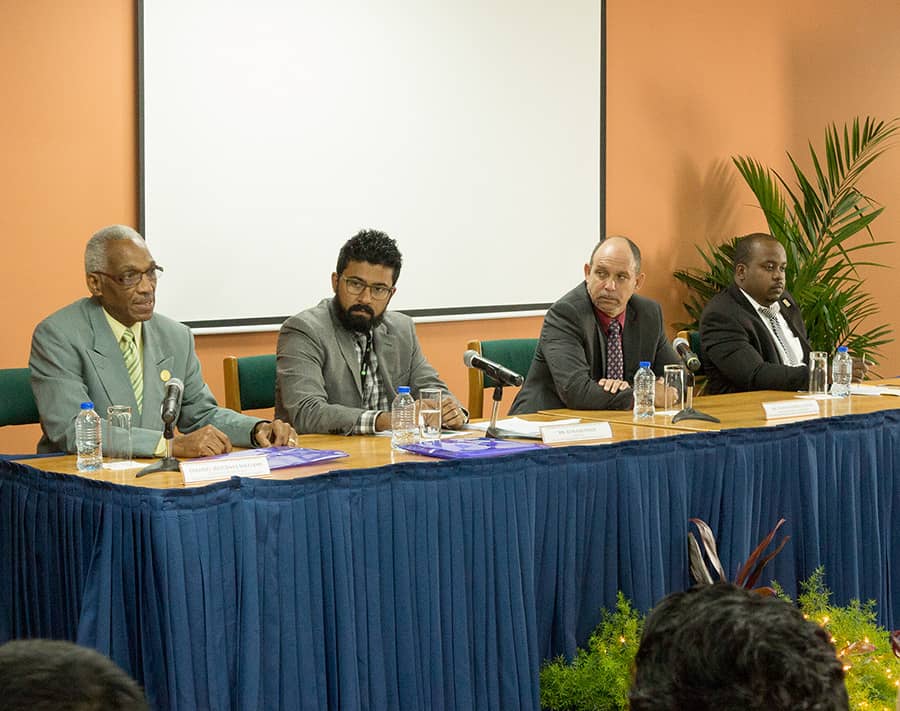
Above: Disaster Communications forum presenters, from left, Colonel (Ret) Dave Williams, Avinash Singh, Dexter Boswell-Innis and Daren Lee Sing. Photo by Mark Lyndersay.
BitDepth#1114 for October 10, 2017
There was something more than a little ironic about stepping carefully around massive puddles of water in the neighboring Republic Bank Staff Club car park to get to the Telecommunications Authority’s (TATT) Open forum on communicating during a disaster.
The 27th ICT Open Forum hosted by TATT, it proceeded under the formal title Resilient Communications: Staying connected during a disaster, and featured contributions from the TT Publishers and Broadcasters Association president, Daren Lee Sing, TSTT’s Avinash Singh representing CANTO, TATT’s Dexter Boswell-Innis and Colonel Dave Williams, CEO (Ag) of the Office of Disaster Preparedness and Management (ODPM).
If the rainy weather didn’t adequately underline the gravity of the proceedings, the streaming videos that popped up on pretty much everyone’s phone showing raging floods in Santa Cruz, Maraval and Diego Martin after an afternoon’s heavy rainfall were a contemporaneous reminder that any deity deemed to be overseeing our good fortune with tropical storms was ready to change passports.

Daren Lee Sing, president of the TT Publishers and Broadcasters Association. Photo by Mark Lyndersay.
The event got off to a shaky start with Mr Lee Sing’s presentation, which reflected some significant misunderstandings of the provisions of the National Emergency Communications Plan, which is currently open for consultation.
Mr Lee Sing did make some critical points about the current fragility of Cumberland Hill, home of much of the major transmission capability in Trinidad, pointing out how easily landslides and falling trees made access to the facility daunting, if not impossible without robust machinery.
“Trees,” he pointed out, “collapse after five minutes of rain.”
Most presenters spoke from prepared slide decks, but these too were desperately in need of remedial works. All offered unreadable information crammed into tiny spaces in font sizes that were far too tiny to be useful to the audience.
Avinash Singh spoke generally from a slide deck that most visibly displayed the company’s new bmobile logo, but noted sensibly that Tropical Storm Brett had tested the preparedness and response capabilities of local telecommunications and it was clear that “tower design, land topography and remote radio unit deployment must now be revisited.”
Colonel (Ret) Dave Williams was the most anticipated speaker of the evening in his role as the current CEO of the ODPM, and while some slack should be cut for him given the critical calls he was fielding about pending disaster during the event, the simple fact is that the tone of his presentation was appalling.
Williams, who is a handsome and patrician elder with a roguish smile, seemed to misunderstand his role as the person leading the country’s response to disaster.
Some elements of his presentation – which it should be noted was cribbed line for line from ECLAC’s research into disaster communications without attribution – made good sense.
“You may be saying, I have power for seven days, but when we are planning, should we be thinking instead about having power for at least seven days?” Williams asked.
“A disaster is a big event but there is big, then there is bigger and there is no limit to how far bigger can be.”
The disaster in Dominica was so complete, he noted, that HAM radio operators lost equipment in the hurricane and the remaining operators were pressed into providing services for the Dominican government and disaster responders.
“What we are finding is that the amateur operators, the HAM operators, the REACT people, can walk to the next village and give us an insight into what’s happening.”
“These operators can be tremendously useful. We have challenges with those folks, it seems, but that’s something that we have to resolve.”
“Can [emergency communications] systems speak to each other? Are they interoperable? I am not so concerned with redundancy, but I do have concerns about interoperability.”
But Williams’ arguments that information critical to disaster response was readily available from multiple sources rang hollow.
“The information is there,” Williams said with a hint of exasperated condescension, “the private sector does its part to disseminate information in its own formats, but we are not paying enough attention to it.”
In referring to the ODPM’s website as an aggregator of useful information, he seemed unaware that the site’s design is adamantly user hostile, opting for style over utility, has a reputation for keeling over in a stiff digital breeze and most damning of all, is not mobile responsive, ensuring that anyone actually getting to it on a smartphone will have an unpleasant, if not unrewarding experience trying to find anything.
“What we are experiencing is an inappropriate reaction to the reality that we face,” Williams cautioned, “we must be prepared.”
If the ODPM CEO ever realises that civilians do not respond well to commands and directives founded on observable error, he will also come to understand that as a communicator, his organisation is itself manifestly unready.




I wish I had gone, and then, based on your observations, I am glad that I did not.
There needs to be a sincere discussion about disaster communications, and frankly, I think government should only be invited – not hosting.